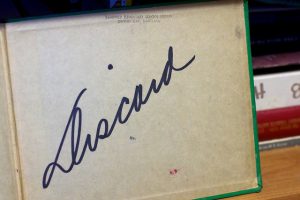Marketing
Television gets a bad rap. Some of it is deserved—I’m looking at you Sharknado—but some of it comes by way of the rarified air some writers breathe. You know the air; it smells a little like antique books and pretension. It’s the air that convinces some of us that if the masses consume it, it can’t be any good.
Sharknado notwithstanding, there is good television out there. There are widely-known, critically acclaimed shows like Game of Thrones and Breaking Bad, and there are lesser known shows, some long-canceled, like Firefly and A Different World, that changed the way viewers engaged with each other and the world. What these shows have in common is their ability to entertain, and we can learn a lot about writing—and our writing careers—from studying them. In an effort to keep this post from being the length of a novel, I’ve focused on a showrunner, two shows, and commercial breaks to provide examples of how television can inform the way authors write and share stories.
1) Shonda Rhimes and the power of a recognizable brand
If you’ve watched anything on ABC over the past few years, you’re probably familiar with Shonda Rhimes. Her shows, Grey’s Anatomy, Scandal, and How To Get Away with Murder, have been rating powerhouses for ABC, reshaping the network’s evening lineup. But what we can learn from Shonda extends beyond powerful writing. If Shondaland, Rhimes’s production company, is associated with a project, viewers know to expect strong but flawed female leads, a diverse cast, and soap opera-like drama. This is Shonda’s brand on ABC, and she delivers it faithfully to her dedicated fans. Know your audience, create what they enjoy, brand it, and repeat.
2) The West Wing and characters we care about
This Golden Globe and Emmy Award winning TV show is a master class on pacing, dialogue, and creating characters people care about. Here’s a scene that accomplishes all three.
Please welcome Laura Heffernan, the author of America’s Next Reality Star and Sweet Reality, to WU today! A little about her:
Laura is living proof that watching too much TV can pay off. When not watching total strangers get married, drag racing queens, or cooking competitions, Laura enjoys travel, baking, board games, and seeking new experiences. She lives in the Northeast with her amazing husband and two furry little beasts.
When Laura first pitched writing a piece on her experience with a large number of promo sites, we thought it could make for a fresh and interesting case study–and it does. Sales are a funny thing, and linked to variables that are often unknowable to us. Laura’s personal analysis of her sales numbers and their correlation with a roundup of ad runs provides food for thought and may introduce you to services you never knew existed.
Thank you, Laura, for taking the time to compile and share your numbers for us!
You can learn more about Laura and her novels on her website, and by following her on Facebook and Twitter.
Do Daily Deal Services Work? One Author’s Experience with 19 Promo Sites
In the middle of June, I got the news that America’s Next Reality Star was going on sale for about six weeks. Immediately, I started looking for daily deal sites to spread the word. I wanted to know which sites work. There’s unfortunately not a lot of information out there, so I did my own experiment. During this time, I signed up for 19 sites that send out daily deal emails to their readers, ranging from free to…not cheap.
This experiment focuses on Amazon for two reasons:
The book is a romantic comedy, so I looked for services that listed this as a separate genre. When it didn’t have one but a site was highly recommended, I chose romance instead. Sales are estimated, based on extensive analysis of the rankings.
My book was 99¢ during this experiment. Books listed for free might get more downloads.
The Free Sites
Six different free services (who shall remain nameless) ran ads for me: 2 on weekend days, 3 on a single weekday, and 1 for two consecutive weekdays. I can sum this up pretty handily: I did not show a single estimated sale on Amazon on any of the days I used free services to advertise my book (other than sales from my Amazon affiliate links).
Most people would say, “You get what you pay for,” and to be honest, I didn’t expect to get loads of sales from a site that didn’t cost me anything. However, most of the sites have paid counterparts. I chose the free service to see if it would be worth signing up for paid promo later. As a business, this is their chance to hook me by showing what great service they provide. None of them did that.
The Cheap Sites ($4.50 – $40)
Run on 2 consecutive […]
Read More
Warning: Hacks for Hacks tips may have harmful side effects on your writing career, and should not be used by minors, adults, writers, poets, scribes, scriveners, journalists, or anybody.
The whole point of publishing a book is so that others will read it. The problem with people reading your books is that they insist on having opinions about them, rather than simply stating the objective fact that your book is better than the complete works of Hemingway and Rowling combined. Whether positive or negative, whether penned by a professional critic in a literary journal or hastily typed by some rando on Amazon, you’ve got to prepare your ego for how to handle book reviews. Here’s how to cope:
What to Do When You Get Good Reviews
Hmm, something tells me this is a good time to segue into dealing with bad reviews.
Read MoreSeeing your book on the silver screen: it’s a universal dream, one that nearly every novelist I’ve worked with has confided that they harbor. Barely a day goes by when an author does not ask me whether I have any Hollywood connections who could help them get a foot in the door.
Sure, I have some loose contacts in “The Industry.” A screenplay writer here, a director there, a financial VP. But that doesn’t mean I can slip someone a manuscript and open doors. Far from it. In fact, how and why certain books get made into movies is a complete mystery to me — as it is to so many others.
Which is why, when I recently met the co-founder and president of production and acquisitions at an L.A. production company associated with Showtime Networks, CBS Films and Netflix over a conversation about a book he was considering making into a movie, I asked if he’d talk me through the process of how, exactly, novels are discovered by the film industry.
I’m delighted that he’s agreed to do so “on the air” here at Writer Unboxed. A warm welcome to Brett Tomberlin of Imagination Design Works (IDW).
Q: In general, where do the ideas for the movies you decide to produce come from?
BT: In most cases scripts come to us though attorneys or agents. Since there are so many lawsuits, you have to be super careful in Hollywood to only take material from an attorney, a manager or an agent with all the legal bases in place.
Sometimes people come in without a script but with a concept. These are usually people we know and have worked with. We know their track record and their capabilities, so we’ll talk to them.
And we do get people coming to us with books. As long as the book is published – whether traditionally or self-published – we can look at it because its publication is a time stamp showing it’s been released out into the public. Legally, this works for us.
Q: About how many of the ideas you get come from books?
Read MoreWarning: Hacks for Hacks tips may have harmful side effects on your writing career, and should not be used by minors, adults, writers, poets, scribes, scriveners, journalists, or anybody.
Have you heard of Patreon? It’s a company that empowers crowd-sourced patronage of the arts, including but not limited to authors. By pledging monthly support at one of various patronage tiers, each with its own level of perks and rewards, you’re able to support your favorite writers directly. I have recently started my own, and it is my fondest wish that your patronage does not include me.
You may know me as famous author Bill Ferris. But I am also a single dad with a full-time job and not very much time to write. By supporting my Patreon, you’re just one more person for whom I must drop what I’m doing and cobble together your monthly rewards, which are terrible. Worse, this busywork distracts me from my main writing projects, to say nothing of spending time with my family or doing my mentally taxing day job.
However, it has come to my attention that you don’t like me, or are at the very least indifferent to my suffering. You are willing to prey upon my greed and bottomless need for praise and validation in exchange for a few lousy entertainments once per month, to diminishing returns. So be it. Behold, the instruments of my destruction. Do your worst, patrons.
Tier 1: Nuisance ($1 or more per month)
You believe you’re supporting me, and I know your heart’s in the right place. You’ll get access to my Patron-only blog, which is a thing I apparently have to write now.
Tier 2: Least-favorite Friend ($5 or more per month)
You’ll get access to my Patron-only blog, as well as a forum where you can ask me questions like I’m some kind of advice columnist, and I’ll be honor-bound to give you guidance of dubious quality. Think of all the things you could buy for five bucks–an ice cream cone, a magazine, a bottle of wine from Trader Joe’s; these are all things that could bring you joy without burdening me with extra work and without further raising your expectations, which I guarantee I won’t live up to.
Tier 3: Troll ($10 or more per month)
Jeez, you’re really serious about this, aren’t you? What do you actually think you’re going to get that’ll be worth $10? I guess I’m now contractually obligated to give you all the “rewards” mentioned above, PLUS the raw, unedited, poorly organized first draft of whatever story, novel, or essay I happen to be working on at the moment. (You’ll notice I capitalized the word “plus” here to imply this is not a perk, but a threat.)
Tier 4: Antagonist ($25 or more per month)
Oh, sorry, I didn’t notice you’d decided to contribute at this level, as I was busy playing catch with my sons whom, by the way, are growing up so fast and will not for long see the world through the innocent eyes of children. Welp, no time for that now, because I guess have to do a live chat/Q&A session with my $25 subscribers. During the sesh, you’ll get to ask me profound questions about writing that I will be […]
Read MoreDeep down inside we writers know that those pie-in-the-sky dreams we all harbor of getting our books reviewed by the New York Times, or featured in Oprah Magazine or on NPR’s Fresh Air are, for the most part, just that: pie-in-the-sky-dreams. A few years back here on Writer Unboxed I gave a glimpse of why.
But let’s fess up: somewhere even deeper down inside, right next to the ache in our heart we’ve been trying to assuage throughout years of solitary drafting, querying and facing the sting of rejection over and over again, is a dense nugget of hope that those pie-in-the-sky dreams will come true. After all, the the New York Times does review a good handful of books. We tell ourselves silently, “one of them could – and should – be mine.”
In my work with authors, I hear this wish articulated over and over again. And I want nothing more than for that wish to come true. When it does — whether we’ve landed a story for one of our authors in The Washington Post or a feature on BuzzFeed, or firmed up an interview with NPR or MSNBC — my team and I text each other in excitement. We stop everything to watch or listen to the interview live. In part, our excitement reflects the fact that this type of high level coverage is painfully rare.
You might think that if you don’t make it to that level of coverage, you’ve failed. That your publisher or publicist has failed. As Kathy Sherbrooke, author of the exquisite debut Fill the Sky recently said to me, “We tend to associate success with what we see “regularly,” i.e., in the major press outlets that we frequent: major newspaper reviews, coverage in significant trade publications and TV interviews.”
Read MorePlease welcome novelist and screenwriter (TV, film) Dale Kutzera to Writer Unboxed today!
Dale grew up in the Pacific Northwest and worked as a screenwriter for over ten years. Among his credits are the VH-1 series “Strange Frequency,” the CBS drama “Without a Trace,” and the independent film “Military Intelligence And You!” He is a recipient of the Carl Sautter Screenwriting Award, and the Environmental Media Award.
His novels include the “Andy McBean” middle-grade adventures.
He has recently released a plotting guidebook for novelists called “The Plot Machine.”
Dale’s “The Plot Machine: Design Better Stories Faster” is a book spot-on for the WU audience; it’s for intermediate writers, not beginners, and proposes a fresh way to think about story — through the design of the plot itself.
You can learn more about Dale and The Plot Machine on his website, and by following him on LinkedIn and Facebook.
It’s a (Mad, Mad) Marketing World
Now more than ever, writing has become a matter of quantity as much as quality. You can blame the 500 channels on your television, the game machine below it, and the millions of books just a click away on your phone or tablet.
That’s a lot of options for story-consumers and a lot of competition for story-producers.
Standing out in this crowd is either impossible or insanely expensive. Television networks, movie studios, and traditional publishers can no longer rely on old-media to reach a wide audience. The top concern of every agent, editor, development executive, and producer is marketing. The first question asked of every manuscript, screenplay, and television pilot is, “How would this be marketed?”
Genre, plot, characters, setting—the traditional elements on which a work is judged—all take a back seat to marketing. This isn’t to say that leaders in the story-industry are blind to quality, just that ease-of-marketing is the first hurdle a project must clear.
1. Branding
If given a choice, would you market a stand-alone story, or the first in a series? Assuming both are of equal quality, the smart choice is the series, because the marketing dollars spent on story #1 would build an audience for story #2.
Franchise or branding potential is the second hurdle a story must clear. A major decision for writers today is whether their property can become a series (the same characters in many stand-alone stories) or a serial (one story spanning several episodes). Star Trek is a series. Harry Potter is a serial.
This pressure to brand has lead to the decline of stand-alone stories, whether individual novels, anthology TV series, Movies of the Week, or the sort of high-minded theatrical films that win Oscars.
2. Name Recognition
The impact of marketing and branding are all around us. These days, it is hard to find a theatrical film that isn’t a sequel, a reboot, or an adaptation of some pre-existing, pre-marketed property.
Stand-alone books or films are typically the work of name creators who have become a brand unto themselves—for example, the comedies of Judd Apatow, or the horror novels of Stephen King. Traditional-media is like a popular nightclub. Only the hipsters with name recognition get past the velvet […]
Read MoreImage – iStockphoto: Celafon
Suiting Up for the Attention Economy
From time to time–many journalists know this moment—it feels as if several stories or trends you’ve been covering (or trying to dodge) start locking into place in some sort of shape or design or purpose. Call it “news relationship syndrome.”
This happened for me at the beginning of the month, and it brought together:
In Berlin, Michael Tamblyn of Kobo had introduced the idea of a “fifth wave” in book retail, and this is something that Jane Friedman and I wrote about in the May 3 edition of The Hot Sheet, our newsletter for authors. Tamblyn was concerned that industry players today might be breathing a sigh of relief and thinking that the digital scare has passed, that they can just “get back to publishing and making books without having to worry about the industry remaking itself.”
Tamblyn describe four historical “waves” of publishing retail:
And then he dropped his bombshell: “The fifth wave,” he said, “isn’t a format shift. And it isn’t a change in where books are sold or distributed. It isn’t subscription vs. single-title sale. It isn’t about how much a book gets sold for at all. Instead, it is the commodification and commercialization of attention.”
Welcome to the wars of attention.
And as we trundle out onto this unholy, “unpresidented” battlefield, I want you to think about this brilliant phrase that Tamblyn lobbed at us like a mic-drop: “It is an arms race of monetized attention.”
The mechanized (algorithmic) warfare around you is being waged by Netflix, Amazon Studios, HBO, Hulu, Showtime, everything on your Roku. Have you heard any of your fellow author-soldiers talk of wanting to get into the miniseries content armies? I have: at London Book Fair, when I spoke on a panel in the Author HQ program in March, the writers in the audience wanted to know about Hollywood. And Hollywood is trying to capture your reader’s attention as a prisoner of war.
“It is about the fight for time,” Tamblyn said. And it’s too easy, he said, to shrug and say that books have always “jockeyed with TV and movies and magazines and newspapers for people’s time.
“Now we live in an attention economy,” he said, in which thousands of companies “have a very clear sense of what people’s time is worth.” In other words, what they can charge for your attention, “what they would like […]
Read MoreThis week I presented a webinar with (the amazing) Jane Friedman, and in the Q&A, someone asked about how to get the attention of readers and influential people who reach them. Today I want to answer that question, and share practical ways you can do this for yourself.
The topic I have been enamored with this month as I shared my book with the world is this:
Generosity is a magic wand.
The most important aspect of this that each of us has that magic wand. The only questions are:
So let’s take this apart piece by piece, and dig into specific ways you can truly stand out in the marketplace via generosity.
Read More



















